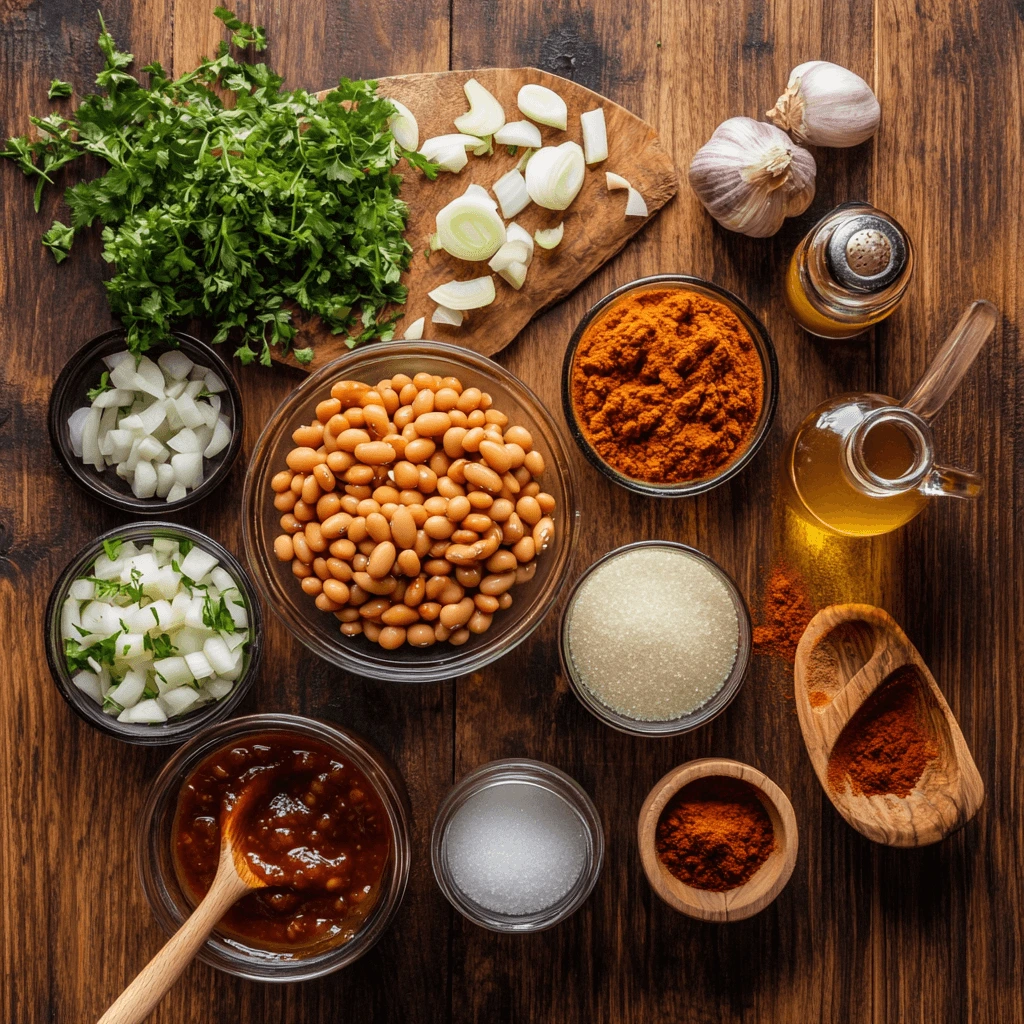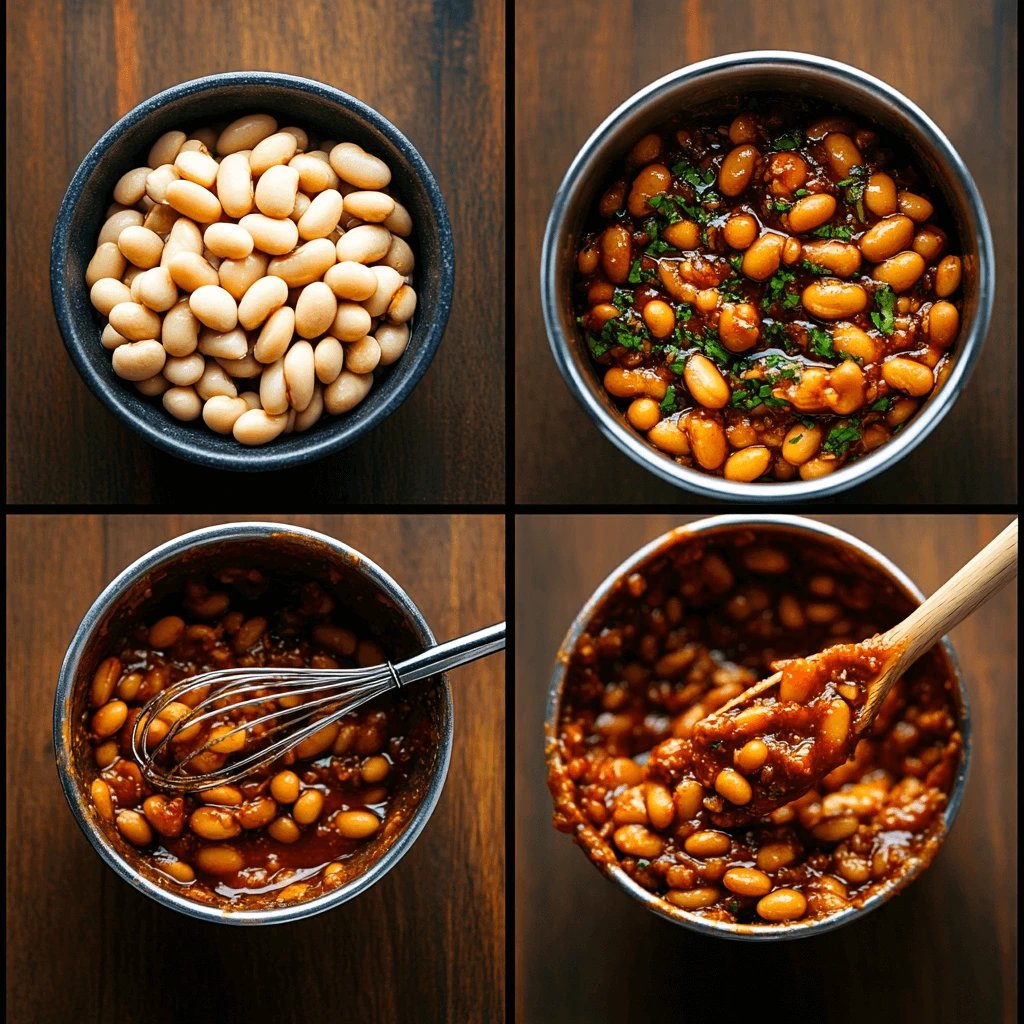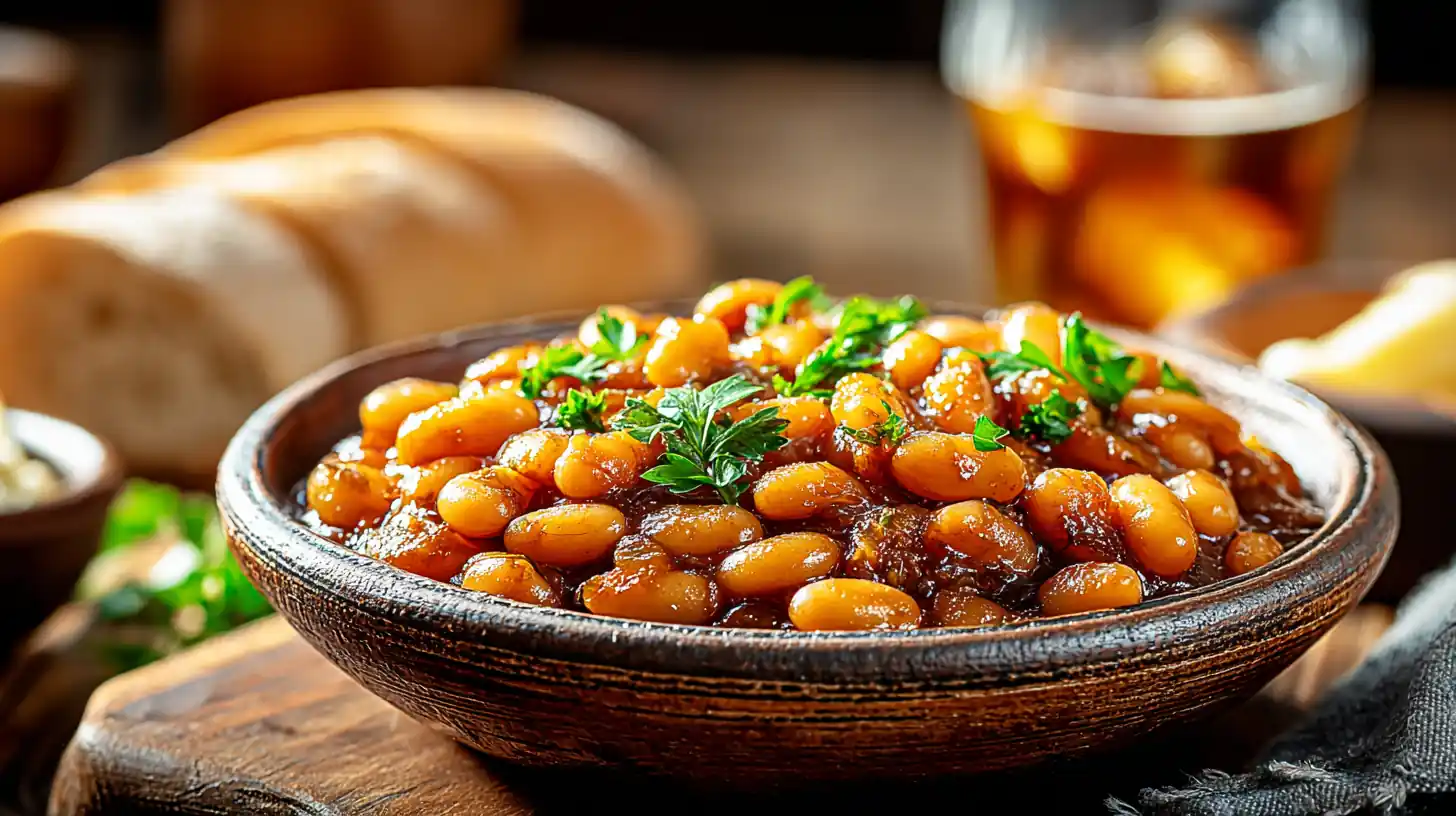
Baked Beans Recipe: How to Make Them Perfect Every Time
- Total Time: 2 hours 50 minutes
- Yield: 6 servings 1x
- Diet: Vegetarian
Description
Rich, savory, and slightly sweet homemade baked beans perfect for BBQs, family dinners, and potlucks. Healthier and customizable compared to store-bought options.
Ingredients
2 cups dried navy beans (or 4 cups canned)
4 cups water (for boiling)
1 cup tomato paste or ketchup
1/4 cup molasses
2 tablespoons brown sugar or maple syrup
1 tablespoon apple cider vinegar
1 tablespoon mustard
1 tablespoon Worcestershire sauce (or soy sauce)
1 teaspoon smoked paprika
1/2 teaspoon garlic powder
Salt and pepper to taste
Optional: 1 diced onion, 1 diced bell pepper, 1/2 cup cooked lentils or chickpeas
Instructions
1. Soak the beans overnight in plenty of water.
2. Drain, rinse, and boil beans in fresh water for 45-60 minutes until tender.
3. In a bowl, combine tomato paste, molasses, sugar, vinegar, mustard, Worcestershire sauce, smoked paprika, garlic powder, and seasoning.
4. Preheat oven to 325°F (160°C).
5. Mix beans with sauce in a baking dish, ensuring beans are fully coated.
6. Cover and bake for 2-3 hours, stirring occasionally.
7. Taste and adjust seasonings before serving.
Notes
For a smoky flavor, add liquid smoke or use smoked paprika generously.
Use canned beans for a quicker version; reduce baking time by 30 minutes.
Store leftovers in an airtight container for up to 5 days in the refrigerator.
- Prep Time: 20 minutes
- Cook Time: 2.5 hours
- Category: Side Dish
- Method: Baking
- Cuisine: American
Nutrition
- Serving Size: 1 cup
- Calories: 320
- Sugar: 12g
- Sodium: 480mg
- Fat: 5g
- Saturated Fat: 1g
- Unsaturated Fat: 3g
- Trans Fat: 0g
- Carbohydrates: 55g
- Fiber: 12g
- Protein: 13g
- Cholesterol: 0mg
Table of Contents
Growing up in Asheville, North Carolina, my grandmother Mabel had a cast-iron pot that never seemed to leave the stove. On chilly afternoons, she’d fill it with navy beans, molasses, and spices, letting the aroma drift through the house like a warm hug. I’d sit at the kitchen table, watching her stir gently with her old wooden spoon, the same one I still use today. That’s where my love for homemade baked beans began – simple, comforting, and full of heart.
Homemade baked beans aren’t just about flavor; they’re about bringing people together. Much like a comforting Amish Hamburger Steak Bake, baked beans create that same cozy atmosphere around the dinner table. Whether it’s a backyard BBQ, a Sunday family meal, or a quiet dinner for one, making them from scratch means choosing exactly what goes in – healthier ingredients, bolder spices, and just the right touch of sweetness. In this guide, I’ll share how to make baked beans that turn out perfect every time, from selecting quality ingredients to mastering the slow-cooking process. Let’s get cooking!
If you enjoy rich, hearty dishes, try serving your baked beans alongside a flavorful Pan Roast for the ultimate family meal.
Why Homemade Baked Beans Are Worth It
Healthier and Tastier Than Store-Bought Alternatives
Store-bought baked beans might be convenient, but they often fall short when it comes to taste and nutrition. These pre-packaged options are usually loaded with preservatives, added sugars, and excessive sodium, which can overshadow the natural flavor of the beans.
Homemade baked beans, on the other hand, give you complete control over the ingredients. You can use fresh, high-quality beans and natural sweeteners like honey or maple syrup to craft a dish that’s not only delicious but also healthier. Plus, you can skip the artificial additives and create a recipe that aligns with your dietary preferences, making it a win-win for both flavor and wellness.
Customizable to Suit Dietary Needs
One of the best things about making your own baked beans recipe is the flexibility to adapt it to various dietary needs. Whether you’re preparing a dish for a vegan guest, avoiding gluten, or simply seeking a lighter option, homemade baked beans can be easily customized to fit your preferences without sacrificing flavor.
Vegan and Vegetarian Options
By skipping animal-based ingredients like bacon or meat broth, you can create a plant-based version that’s just as satisfying. Swap in vegetable stock and add a touch of smoked paprika or liquid smoke for that rich, savory flavor traditionally associated with baked beans. For an extra protein boost, consider mixing in cooked lentils or chickpeas.
Gluten-Free Adjustments
If you’re cooking for someone with gluten sensitivity, ensure all your ingredients are gluten-free. This includes double-checking the labels on mustard, ketchup, and any sauces you use in the recipe. Opt for naturally gluten-free thickening agents like cornstarch to keep the sauce silky smooth without adding unwanted allergens.
Lower-Sugar and Low-Sodium Variations
For those watching their sugar intake, substitute molasses or brown sugar with natural sweeteners like maple syrup or a small amount of honey. Similarly, you can control the salt content by using low-sodium vegetable broth and reducing added salt. A splash of apple cider vinegar can enhance the flavor without relying heavily on sodium.
Perfect for Family Meals, BBQs, and Potlucks
Baked beans are a timeless classic that fits seamlessly into almost any occasion. Their rich flavor, comforting texture, and versatility make them a crowd-pleaser at family gatherings, summer BBQs, and potluck dinners.
A Family Favorite for Everyday Meals
Whether served as a side dish or paired with fresh cornbread, baked beans bring warmth and heartiness to any dinner table. They’re particularly great for busy weeknights, as they can be made ahead of time and reheated without losing their flavor. Plus, kids love the slightly sweet and tangy taste, making it a surefire hit with the whole family.
The Star of Every BBQ Party
No BBQ spread is complete without a pot of perfectly baked beans. They pair beautifully with grilled vegetables, burgers, or skewers, adding a savory-sweet balance to your menu. Their ability to stay warm for hours makes them ideal for outdoor gatherings, ensuring guests can enjoy them throughout the event.
A Reliable Dish for Potluck Dinners
When attending a potluck, bringing a dish that’s easy to transport, serves a crowd, and stays delicious over time is key. Baked beans check all those boxes. They’re easy to portion, reheat well, and complement almost any other dish on the table. Plus, they’re a great way to accommodate vegetarians and omnivores alike with minor adjustments to the recipe.
Ingredients for the Perfect Baked Beans Recipe

Essential Ingredients for the Perfect Baked Beans Recipe
Creating the perfect baked beans starts with choosing the right ingredients. Each element plays a role in building the dish’s flavor and texture.
The Beans
Navy beans are the traditional choice for baked beans. They are small, tender, and soak up flavors beautifully. You can also use other varieties like great northern beans or pinto beans if preferred.
The Sweetness
Sweetness is key to balancing the tangy and savory flavors. Use molasses for a deep, rich taste. For a sweeter Southern-style touch, take inspiration from classics like Amish Peanut Butter Cream Pie. Brown sugar or maple syrup works well for a slightly lighter sweetness.
The Sauce
A good sauce ties everything together. Tomato paste or ketchup forms the base, while mustard, vinegar, and Worcestershire sauce add tang and complexity. Adjust the proportions to suit your taste. For a flavor balance similar to dishes like Honey Walnut Chicken, experiment with adding a touch of soy sauce or extra vinegar.
Optional Add-Ins
For added depth, consider adding smoked paprika, garlic, or diced onions. These ingredients enhance the dish without overwhelming it.
By combining these ingredients thoughtfully, you’ll create a baked beans recipe that’s flavorful and unforgettable.
Optional Add-Ins for Flavor
Take your baked beans to the next level by experimenting with optional add-ins. These ingredients can enhance the depth of flavor and create a more personalized dish.
Smoked Paprika
Smoked paprika adds a subtle smokiness without overpowering the dish. It pairs beautifully with the sweetness of the sauce and creates a barbecue-style flavor. Just a teaspoon can make a noticeable difference.
Liquid Smoke
If you love the taste of smoked meats but want a vegetarian option, liquid smoke is a fantastic addition. A small dash is enough to give your beans a rich, smoky aroma. Use sparingly to avoid overpowering the other flavors.
Apple Cider Vinegar
Apple cider vinegar brightens the sauce with a tangy kick. It balances the sweetness from molasses and brown sugar while enhancing the overall taste. Add a teaspoon at a time, tasting as you go to avoid making it too acidic.
These add-ins allow you to customize your baked beans to suit your flavor preferences, creating a dish that’s uniquely yours.
Ingredient Substitutions for Dietary Preferences
Making baked beans for specific dietary needs is simple with a few thoughtful substitutions. These swaps ensure the dish remains flavorful and inclusive.
Sweetener Alternatives
If you’re avoiding refined sugar, swap brown sugar or molasses with maple syrup or honey. Both add natural sweetness and a hint of complexity. Maple syrup works particularly well for vegan recipes.
Low-Sodium Options
To reduce salt, use a low-sodium vegetable broth instead of water for cooking the beans. Opt for no-salt ketchup or tomato paste to keep the sauce flavorful without excess sodium.
Gluten-Free Adjustments
For gluten-free recipes, double-check ingredient labels, especially on Worcestershire sauce and mustard. Many brands offer gluten-free versions. Cornstarch or arrowroot can also replace flour if you need to thicken the sauce.
These substitutions ensure everyone can enjoy your baked beans, no matter their dietary needs.
Step-by-Step Guide to Making Baked Beans

Getting the Beans Ready
Achieving tender, flavorful baked beans begins with careful preparation of the beans from the very start. Here’s how to set up their texture and flavor right from the start.
- Soaking for Softness
Start with dried navy beans. Let the beans rest overnight in a generous amount of water to soften and hydrate fully. If you’re in a pinch, bring them to a boil for 2 minutes, then cover and let them sit for an hour as a faster alternative. - Cleaning and Sorting
After soaking, rinse the beans under cold water, removing any foam or cloudy water. Pick out any beans that look shriveled or off-color. - Cooking Until Just Tender
Place the soaked beans in a pot with fresh water. Bring them to a gentle simmer and cook for 45-60 minutes, checking that they become tender without falling apart. Avoid seasoning them yet – salt can firm up the skins too soon. - Quick Option: Canned Beans
When time’s tight, drained and rinsed canned beans can fill in. They won’t absorb sauce as deeply but make a solid shortcut.
Building the Perfect Sauce
What sets baked beans apart is the sauce: a bold blend of sweetness, tang, and subtle smoky depth.
- Sweet Base Creation
Mix molasses with a bit of brown sugar or maple syrup to establish a deep, caramel-like sweetness. - Bright and Tangy Layers
Blend in apple cider vinegar or lemon juice to sharpen things up. Mustard adds that subtle edge. - Umami and Smoky Touches
Worcestershire sauce or soy sauce enhances depth. Smoked paprika or a dash of liquid smoke brings in that backyard BBQ aroma. Garlic powder or fresh minced garlic rounds it all out. - Balancing the Texture
Combine ketchup or tomato paste with broth or water until the sauce is pourable but not thin. Whisk everything until smooth.
Bringing Everything Together
Once your beans and sauce are ready, it’s time to combine and cook everything slowly to develop that signature baked beans taste.
- Mixing It Up
In a baking dish, gently fold the sauce into the beans until fully coated. Add a little broth if things look too thick. - Slow Baking for Best Flavor
Preheat your oven to 325°F (160°C). Cover your dish and bake for 2-3 hours, stirring now and then. This slow, steady cooking draws the sauce deep into each bean. - Alternative Cooking Methods
If you prefer, simmer the beans gently on the stovetop or let them cook in a slow cooker for 6-8 hours on low, stirring occasionally. - Final Seasoning Check
Before serving, taste the beans. Adjust sweetness, tanginess, or salt as needed. Let them sit for about 10 minutes before plating – this helps the sauce thicken naturally.
Tips for Customizing Your Baked Beans
Adjusting Sweetness, Tanginess, and Smokiness
Customizing the flavor of your baked beans is one of the joys of making them at home. By tweaking the balance of sweetness, tanginess, and smokiness, you can create a dish that perfectly suits your taste.
Adjusting Sweetness
If you prefer sweeter baked beans, increase the amount of molasses, brown sugar, or maple syrup in your sauce. For a more natural sweetness, add finely chopped dates or a splash of apple juice. Keep in mind that a little goes a long way, so adjust gradually and taste as you go.
Balancing Tanginess
Tanginess is essential for cutting through the richness of the sauce. A splash of extra apple cider vinegar, fresh lemon juice, or a spoonful of mustard can lift the flavor and add a zesty touch. If the dish becomes too tangy, balance it out by adding a small amount of sugar or a touch of honey.
Enhancing Smokiness
For deeper, more layered flavor, blend in smoked paprika, a dash of liquid smoke, or a hint of chipotle powder for gentle heat. If you like an extra bold flavor, stir in diced fire-roasted tomatoes or smoked onions.
By adjusting these elements, you can make baked beans that are perfectly balanced and uniquely yours, no matter the occasion.
Adding Vegetables for Extra Nutrition
Incorporating vegetables into your baked beans is a simple way to boost their nutritional value while enhancing flavor and texture. This customization works well for families and those seeking a healthier version of this classic dish.
For a lighter side, pair baked beans with simple dishes like 3-Ingredient Creamed Spinach to round out your meal.
Onions and Garlic
Finely chopped onions and fresh garlic bring essential savory notes to your baked beans. They add a savory base to the dish, enriching the sauce with natural sweetness as they cook. Gently cook them in a skillet first to unlock their full aroma before adding them to the sauce.
Bell Peppers
Chopped bell peppers add both subtle sweetness and bright color, making the dish more appealing. Red, yellow, or orange bell peppers work especially well. Dice them finely for a subtle texture or leave them in larger chunks for a more noticeable bite.
Carrots and Celery
Shredded carrots or chopped celery are excellent ways to add nutrients without altering the flavor too much. Carrots add a hint of natural sweetness, while celery provides a subtle crunch. These vegetables blend seamlessly into the dish as they soften during cooking.
Mushrooms for Depth
Mushrooms contribute a rich, earthy taste and a hearty bite that complements the beans perfectly. Button, cremini, or even shiitake mushrooms can complement the richness of the sauce. Sauté them beforehand to release their juices and deepen their flavor.
Adding vegetables not only makes your baked beans healthier but also adds layers of flavor and texture that elevate the dish to new heights.
Making It a Full Meal with Proteins
Make baked beans more filling by mixing in extra plant-based proteins or other hearty ingredients. This customization makes them more filling and versatile for lunch or dinner.
For casual gatherings, baked beans also pair wonderfully with Pierogies and Kielbasa in a Crockpot, offering variety on your potluck table.
Chickpeas
Chickpeas, also known as garbanzo beans, are an excellent protein source and blend well with baked beans. Their slightly nutty flavor and firm texture add variety to the dish. Add a cup of cooked or canned chickpeas to your baked beans before cooking.
Lentils
Lentils are a fantastic addition for boosting protein while keeping the dish vegetarian or vegan. Red or green lentils work well, as they soften and absorb the flavors of the sauce. Prepare lentils ahead of time, or opt for canned ones to save time without losing texture.
Tofu or Tempeh
For a vegan-friendly protein boost, add crumbled tofu or small cubes of tempeh into your baked beans. Marinate them in soy sauce or your favorite spices for extra flavor before mixing them with the beans. These options provide a satisfying, meaty texture without using animal products.
Egg or Fish-Free Alternatives
To cater to diverse dietary needs, add textured vegetable protein (TVP) or soy curls. These protein-packed alternatives soak up the sauce beautifully, ensuring every bite is flavorful.
Adding proteins to your baked beans not only makes them more satisfying but also turns them into a complete meal that’s perfect for any time of day.
Common Mistakes to Avoid When Cooking Baked Beans
Getting the Bean Texture Right
Perfect baked beans depend on beans that are tender yet hold their shape. Here’s how to avoid two common missteps:
- Why Pre-Soaking Is Non-Negotiable
Skipping the soak can cause uneven texture. Letting beans soak overnight helps them cook more evenly, ensuring a soft bite rather than a tough one. - Boiling and Baking Time Awareness
Beans that cook too long turn soft and lose structure. If they’re undercooked, they stay firm and chewy. Watch them closely during both the initial simmer and the slow bake. You want them just tender enough to hold their shape while absorbing all that delicious sauce. - Slow Cooking for Flavor Absorption
Baking baked beans at 325°F (160°C) is ideal. Stir now and then, and test the texture about halfway through. Cooking the beans slowly at a steady temperature helps them absorb rich flavors while staying firm and intact.
Balancing the Sauce Consistency
Another common issue? If not carefully monitored, baked beans can easily become watery and loose or dense and overly firm.
- Measuring Liquids Thoughtfully
Pay attention when adding molasses, tomato paste, and broth. Adding extra liquid can make the sauce thin and bland, while too little leaves it thick and heavy. It’s about finding that middle ground. - Mid-Cook Adjustments
As the beans bake, the sauce thickens naturally. Stir gently and check its texture. If the sauce becomes overly thick, gently stir in a splash of broth or water to loosen it. When the sauce feels too thin, finish baking with the lid off for 15-20 minutes to allow moisture to naturally cook off. - Keeping an Eye on Absorption
Beans naturally absorb liquid as they cook. If the dish starts looking dry, pour in a little extra liquid slowly – small amounts keep the flavor concentrated without making things watery.
Forgetting to Taste As You Go
Even a great recipe needs tasting checks throughout cooking.
- Taste Before Baking
Once you’ve combined everything, pause and sample the sauce. Does it need more sweetness or a sharper edge? A little extra molasses, mustard, or smoked paprika can make a big difference. - Mid-Bake Flavor Checks
Stir during baking and taste again. If things lean too sweet, a dash of vinegar or lemon can balance it. Too tangy? A spoonful of sugar or maple syrup helps even things out. - Final Seasoning Touch
When the beans come out of the oven, give them one last taste test. Adjust salt, pepper, or spices while the dish is still warm. This ensures a bold, balanced flavor right up until serving.
Bonus Pairing Suggestions:
For a complete meal, enjoy these baked beans alongside a comforting Pan Roast. Or start with a light appetizer like Crab Brulee before diving in.
Frequently Asked Questions About Baked Beans
How do you make baked beans?
To make baked beans from scratch, start by soaking navy beans overnight, then simmer them until tender. Prepare a sauce using tomato paste, molasses, vinegar, mustard, and spices. Combine the beans with the sauce in a baking dish, cover, and bake at 325°F (160°C) for 2-3 hours. Stir occasionally and adjust the seasoning before serving for best flavor.
Are baked beans actually healthy?
Homemade baked beans can be a healthy choice. They provide plant-based protein, fiber, and essential nutrients like iron and magnesium. By controlling the ingredients, you can reduce added sugar and sodium compared to canned versions. Using natural sweeteners and skipping processed additives makes them a nutritious side or meal component.
What kind of beans are used in baked beans?
The most commonly used bean for baked beans is the navy bean due to its small size and ability to absorb flavors well. Other varieties like great northern beans or pinto beans can also be used, offering slight differences in texture and taste depending on your preference.
What is the best way to eat baked beans?
Baked beans are incredibly versatile. Enjoy them as a side dish with grilled meats, incorporate them into a breakfast plate with eggs and toast, or serve them with cornbread for a classic Southern pairing. They also work well as a topping for baked potatoes or even as part of a hearty casserole.
Follow me on Facebook for daily updates and community fun.

